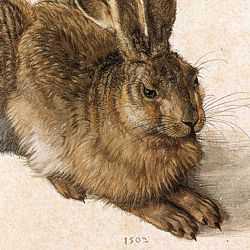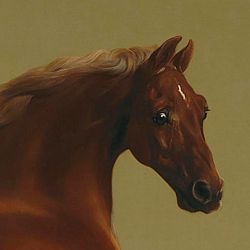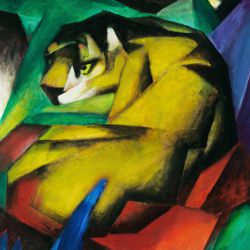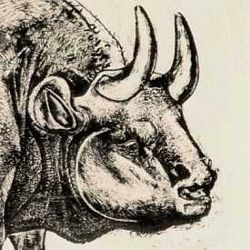Animals in Art - George Stubbs
George Stubbs is the greatest painter of horses in British art and arguably the best in the history of art.
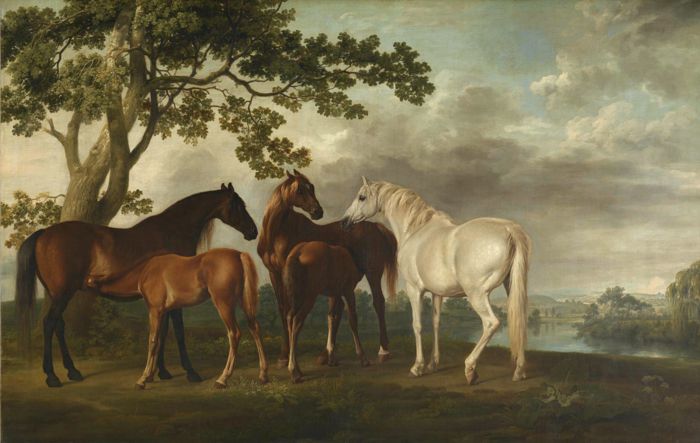
GEORGE STUBBS (1742-1806)
'Mares and Foals in a River Landscape', 1763-68 (oil on canvas)
George Stubbs is the greatest painter of horses in British art and arguably the best in the history of art. However, Stubbs was not always regarded as a great artist. In his own day he was considered to be a mere horse painter, a second class subject in the eyes of the art establishment. Equestrian art, which was included within the genre of 'sporting art', was looked down upon by the critics and connoisseurs, probably due to its rural patronage. As it was the hunting, shooting and racing gentry who were Stubbs' greatest patrons, he tended to be overlooked as a serious artist. However, time strips away all prejudice about an artist's achievements and in the 20th century his reputation was firmly re-assessed to establish him as as one of the greatest masters of the 18th century.
George Stubbs' subjects may reflect the romantic idealism of their age but they are lifted above the sentimental by their skilful composition and intense observation which generate the gravitas that marks all great art. In the 1760's Stubbs painted a series of about ten pictures of Mares and Foals that were set against traditional views of the English countryside.
'Mares and Foals in a River Landscape' is one of the best of the series. The mares greet one another in a dignified silence while the foals feed from their mothers. These noble creatures are completely at ease in their peaceful landscape. Stubbs cleverly incorporates the horses into the landscape by using a subtle counter-change of tones to integrate them with the background: he contrasts the light profile of the white horse against a dark cloud in order to counterbalance the dark profiles of chestnut mares against the light sky. This tonal exchange is mirrored in the layout of the landscape where the bright billowing clouds are echoed by the dark forms of the tree. Even the foals seem to draw milk from their mothers in much the same way that the land draws sustenance from the river. This is an idyllic vision of a Utopian world uncorrupted by the presence of man.
Mares and Foals
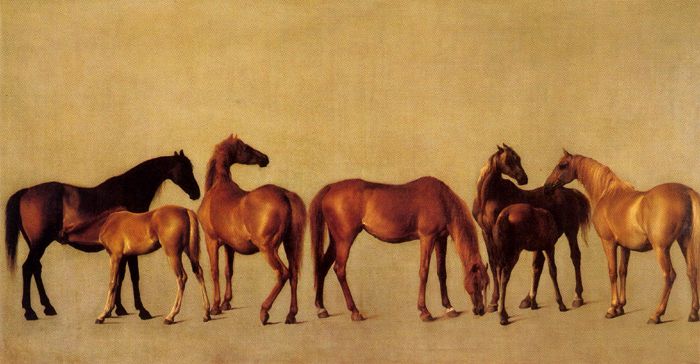
GEORGE STUBBS (1742-1806)
'Mares and Foals without a background', 1762 (oil on canvas)
George Stubbs was known to paint his horses first and their backgrounds later. It was the horses that demanded Stubbs' attention and any background, although brilliantly executed with superb skill, was of secondary importance. Therefore, it should not be surprising that many consider 'Mares and Foals without a background' from 1762 to be the best painting in the series.
This may be an unfinished work or it could have been a study for the development of other paintings - you can see a similar configuration of horses in 'Mares and Foals in a River Landscape'. Either way it is still a masterpiece. The composition is arranged in a frieze-like design which unfolds with classical composure. The lack of a background only serves to focus our attention on the magnificent physique of each of these graceful creatures as they quietly commune with one another. The rhythmic movement of their backs and legs is a melodic reflection of their gentle temperament and latent energy. It is the balance between the intense realism of Stubbs painting and the abstract movements of line, shape and tone across the composition that makes this image so appealing to modern eyes.
Whistlejacket
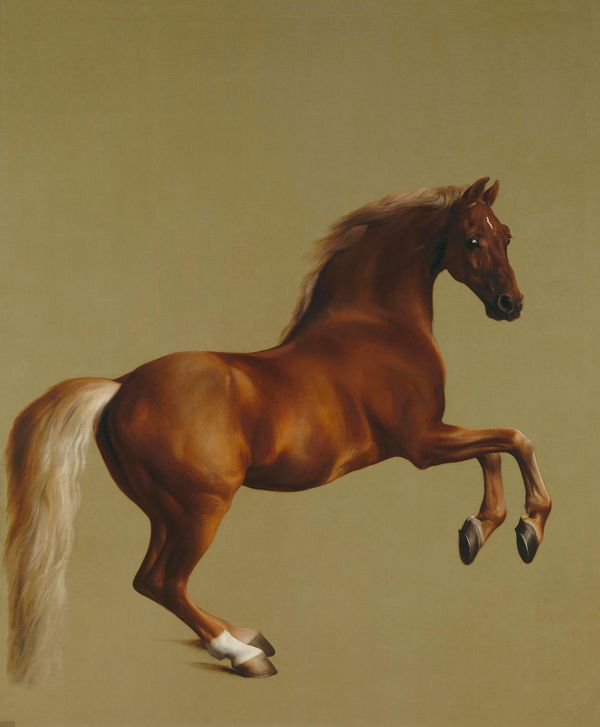
GEORGE STUBBS (1742-1806)
'Whistlejacket' 1762 (oil on canvas)
Stubbs' most famous painting of a horse is 'Whistlejacket'. This champion racehorse was owned by the 2nd Marquess of Rockingham who commissioned Stubbs to paint many of the horses in his stables. The scale (around 10 feet high) and pose is typical of an equestrian portrait without the rider. It was suggested at the time that the rider should have been George III but there is no evidence to confirm this. The quality of this painting lifts it out of the equestrian genre and elevates it to the status of portraiture. This wonderful horse has a more dynamic personality and glows with more vitality than most portraits you could think of.
The Anatomy of the Horse
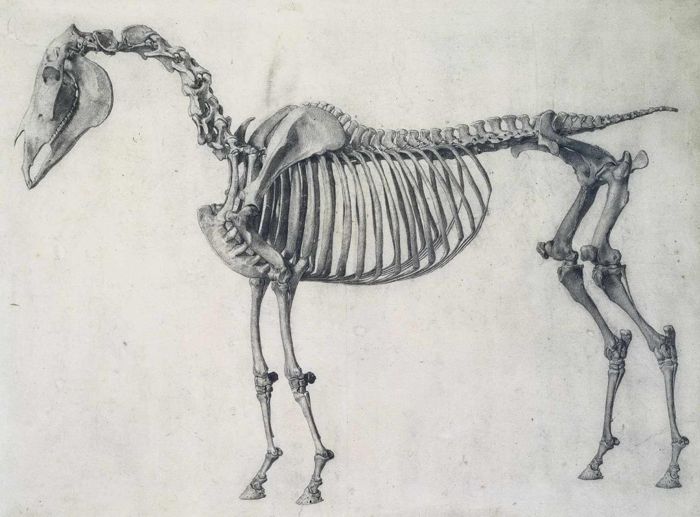
GEORGE STUBBS (1742-1806)
'The Skeleton of a Horse' 1766 (engraving)
George Stubbs' superb skill and accuracy in the painting of horses was enhanced by his unsurpassed knowledge of equine anatomy.
Born the son of a Liverpool currier, as a child Stubbs helped his father to prepare horse hides for the local tannery. In 1756 he moved with Mary Spencer, his lifelong partner and assistant, to a remote farmhouse in Lincolnshire to begin work on 'The Anatomy of The Horse'. This was a book of engravings that illustrated the horse in layers from its skin down to its skeleton. With a ready supply of cadavers from a nearby tannery, he suspended horses on hooks from the roof, positioning the animals in the poses he required. He then carefully 'peeled' the creatures, removing their layers of skin, then muscles until only their skeletons remained. At each stage he meticulously recorded his dissections from a range of different angles. It took Stubbs eighteen months to finish his drawings and notes but, on completion he could not find a publisher. With typical determination he took on the task of engraving the illustrations himself, and after eight years work 'The Anatomy of The Horse' was finally published in 1766 - and it is still in print today.
George Stubbs Notes

GEORGE STUBBS (1742-1806)
'Self Portrait' 1781 (oil on canvas)
George Stubbs is considered by many to be the greatest painter of horses in the history of art.
-
Stubbs always painted his horses first and the background later.
-
Many think that his horse paintings without backgrounds are his greatest works.
-
Stubbs could paint horses in such realistic detail because he had great knowledge of their anatomy.
-
Stubbs dissected horses to learn about their anatomy.
-
From his research, he published the illustrated book 'The Anatomy of the Horse' which is still in print today.

